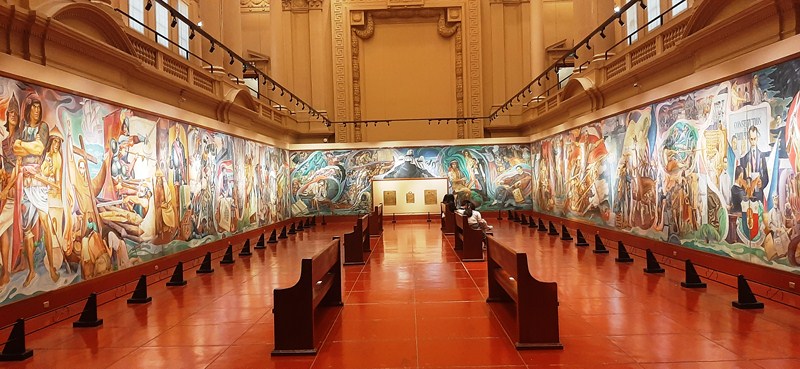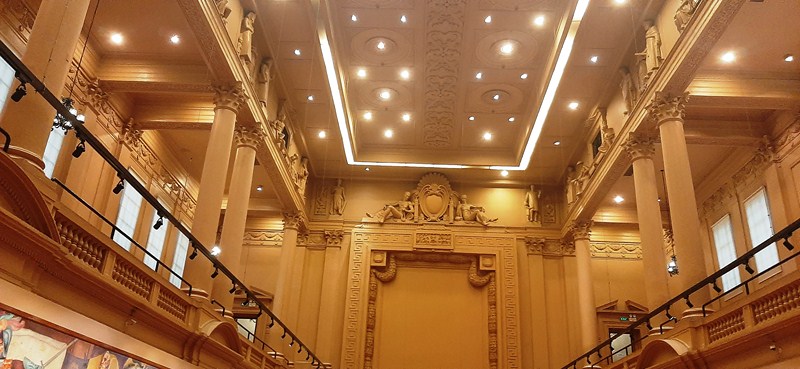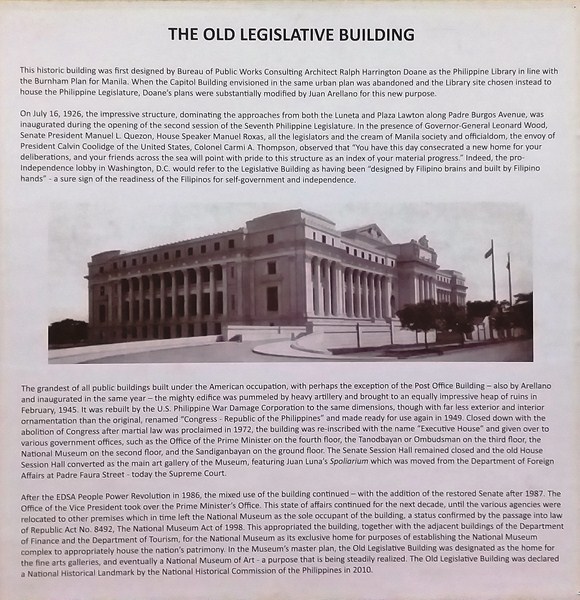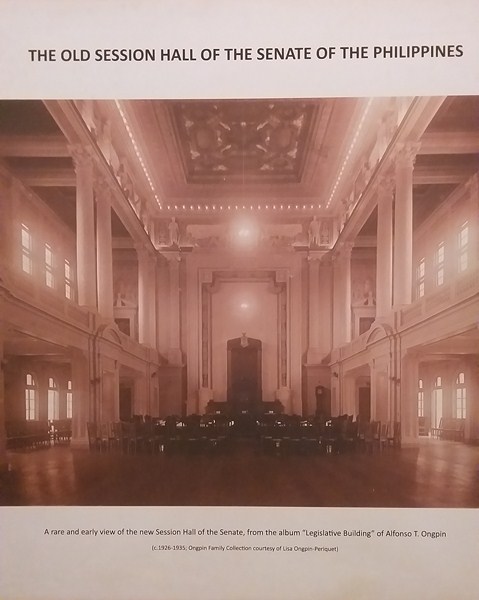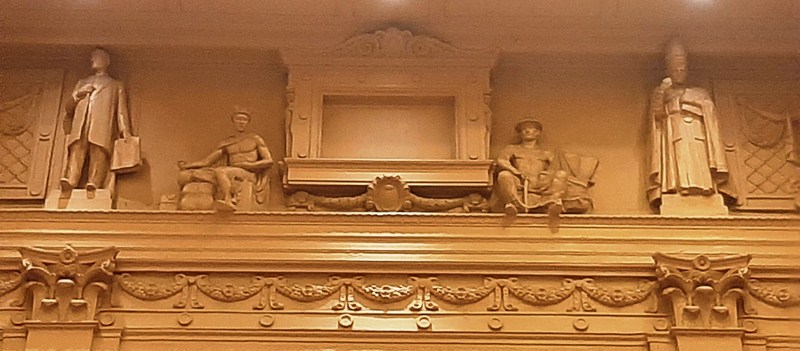The historic Old Senate Session Hall, considered the core of the then Legislative Building (now the National Museum of Fine Arts), was home to members of the Philippine Senate from 1926 to 1996. It had been a silent witness to history as senators, from various eras, debated and charted the future of the Philippines, from the country’s growing clamor for full independence from the United States in the 1930s to its rejection of a new US bases treaty in 1992. Directly below the Senate Session Hall is another hall once used by members of Congress. It has since been converted to a gallery displaying Juan Luna’s “Spoliarium.”
Check out “Old Legislative Building,” “National Museum of Fine Arts” and “Spoliarium Hall”
The old Senate Session Hall was designed by American architect Ralph Harrington Doane (part of the team of architect and urban planner Daniel Burnham and a consultant to the Bureau of Public Works, a precursor of the Department of Public Works and Highways) as a high-ceiling reading room. Heavily damaged during the American liberation of Manila in 1945, the Legislative Building was in near ruins but, for some reason, the Session Hall remained intact, with only its intricately carved hardwood ceiling blown off.
When the newly independent postwar government worked on rebuilding the structure, it was able to restore much of the Session Hall to its original state.
Here, then Senator Benigno “Ninoy” Aquino Jr. and his allies in the opposition delivered privilege speeches during the run-up to martial law in 1972. When martial law was declared, it was closed and later turned into one of the National Museum’s galleries during the remainder of the Marcos years. During the Marcos era, the Batasan Pambansa in Quezon City housed the parliament.
When democracy was restored after the People Power Revolution in 1986, the Senate and Congress returned to their old homes in the Legislative Building. In 1996, after the Senate moved to its new home at the GSIS Building in Pasay City, the old Session Hall was closed again.
In April 2010, work on the Session Hall’s (Php20 million) two-year restoration started, with funding coming from 2011 National Museum endowment fund (Php6 million) of the Philippine Amusement and Gaming Corp. (PAGCOR), and Php14 million from the museum’s 2012 budget. They also tapped the expertise of the museum’s four heritage architects led by Evelyn Esguerra.
During the in-house restoration project, the National Museum’s Jeremy Barns (director) and Ana Labrador (assistant director) pored over old pictures in their attempt to produce a newly restored Session Hall that’s as close as possible to the original. Its prewar look became the peg of the restoration work. Barns and Labrador chose the 1930s, because it was during this period that the country’s independence movement started to intensify.
However, in the absence of detailed pictures of the original, they left the venue’s less ornate postwar ceiling intact. Workers searched in vain for murals (painted by architect Juan M. Arellano), between the overhead concrete fretwork, that might be hidden underneath layers of old paint. In the end, the pair decided to simply give both the ceiling and spaces between the statues a fresh coat of the standard, rich color paint for nearly all public buildings during the Philippine Commonwealth period paint (which Barns described as a “Bureau of Public Works cream”).
The already structurally unsound wooden parquet flooring on the first level, not part of the Session Hall’s original design, was also removed. In keeping with the Session Hall’s original look, they decided to go for vibrant red floors (sealed with epoxy) and baseboards. A series of damaged concrete balustrades that bore the weight of a wooden floor that bisected the 15 m. high Session Hall was replaced with faithful reproductions crafted by House of Precast. The team also replaced the venue’s lighting system and had a more modern, energy-efficient air-con system installed.
Windows that were permanently locked from the outside (because of a concrete barrier) were replaced and opened up. Workers also had to fashion, upon Barns’ instructions, a French-type window that leads to an outdoor veranda. On October 29, 2012, during a celebration of the museum’s 111th anniversary, the refurbished hall was opened.
Currently a venue for events that are of national importance, the Old Senate Session Hall features modern and contemporary Philippine art from the 20th to the 21st centuries. All the ornamentation and decoration in this Hall were done by leading Filipino prewar sculptor Isabelo Tampinco who created these figures with the help of his sons, Angel and Vidal, who inherited their father’s artistry and skills.
These exceptional, restored masterpieces make up an entablature of garlands and Filipinized, classical relief sculptures of great lawmakers, moralists, philosophers and various historical figures in history, from Biblical times to the 20th century, such as Apolinario Mabini, Pope Leo XIII, Woodrow Wilson, Moses, Hammurabi, Ramses the Great, and Charlemagne.
This hall also features seven of the ten panels of “Filipino Struggles Through History” (also known as “History of Manila”), the monumental series of paintings by National Artist Carlos “Botong” V. Francisco (1912-1969) commissioned in 1968 for the Manila City Hall by Mayor Antonio J. Villegas. The last three panels, depicting Mayor Antonio J. Villegas‘ vision for the city of Manila, are exhibited at Gallery XIII, within the same museum’s Vicente and Carmen Fabella Hall.
Check out “Gallery XIII”

Commemorative plaque of the “Filipino Struggles Through History,” by Carlos “Botong” V. Francisco, being declared as a National Cultural Treasure
The artwork was declared as a National Cultural Treasure by then National Museum director Gabriel S. Casal on April 8, 1996. They collectively measure 2.7 m. (8.9 ft.) high and 79.4 m. (260 ft.) wide.
National Museum of Fine Arts: Padre Burgos Avenue, Ermita, Manila 1000, Metro Manila. Tel: (632) 8527-1215 and (632) 8298-1100. Email: inquiry@nationalmuseum.gov.ph. Website: nationalmuseum.gov.ph. Open Tuesdays to Sundays, 9 AM – 4PM. Admission is free. Coordinates: 14°35′13″N 120°58′52″E.

